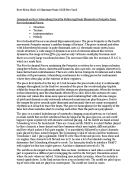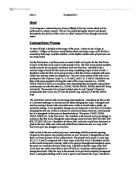The History of Jazz
The History of Jazz Jazz is a type of music that was firstly developed around the year 1895 in New Orleans. To create this type of music, elements from many types of music were mixed, including Ragtime, marching band music, and blues. The difference between this newly developed music called Jazz, and the earlier styles of music was the improvising that was done to the music, by many of the players in each band or orchestra. Jazz music was very different to the traditional Western Music, and was a "break " For Jazz players to play in a Jazz band in the earlier years, they were simply given a few notes of chords to play in, which they would create their own melodies from. This is what made Jazz so unique, how every instrument would be playing their own separate, individual melody, but the instruments were able to fit together as a few notes would be given, and every instrument would be playing in the same key. The first Jazz was played by African-American and Creole musicians in New Orleans. The cornet player, Buddy Bolden was considered to be the first musician to play Jazz music ever. He was unable to use his Jazz music as a proper job, and had to find other jobs elsewhere. Once Jazz had been formed into a "proper" music, small bands began to play Jazz in their music, such as Joe King Oliver, Kis Ory and Jelly Rell. This bands mainly held older men, and increased
THE STATE OF GLOBAL GOVERNANCE ON TERRORISM
The 1920s: A New Era in American History "Girls dancing the Charleston. Gangsters carrying machine guns. Charlie Chaplin playing comical tricks. These are some of the pictures that come into people's minds when they think of the United States in the 1920s. The roaring twenties. Good times. Wild times" (Callaghan, 2000, p. 92). The images of the 1920s - jazz, bootleggers, flappers, talkies, the Model T Ford, Babe Ruth, Charles Lindbergh's history-making flight over the Atlantic have remarkably marked the US history. Hard-won vote for women, racial injustice, censorship, widespread social conflict, and the birth of organized crime, on the other hand, were the bitter memories of the roaring twenties In the Twenties, the American people soared higher and fell lower than they ever had before. The controversial era also evidenced an unprecedented economic prosperity, sweeping social change and the emergence of many institutions, ideas, and preoccupations (Miller, 2003). The US Economy in the 20s The Jazz Age takes its name from jazz music, which saw a tremendous surge in popularity among many segments of society. Among the prominent concerns and trends of the period include the public embrace of technological developments (typically seen as progress)-cars, air travel and the telephone-as well as new trends in social behavior, the arts, and culture (Wikipedia, 2006, Jazz Age).



















